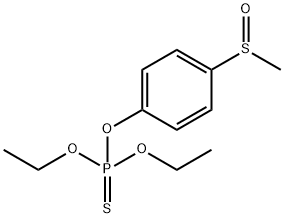펜술포티온
|
|
펜술포티온 속성
- 녹는점
- 25°C
- 끓는 점
- bp0.01 138-141°
- 밀도
- 1.2020
- 저장 조건
- 0-6°C
- 용해도
- 클로로포름(난용성), 에틸아세테이트(소량으로 용해), 메탄올(난용성)
- 수용성
- 1.54g/L(25℃)
- Merck
- 13,4028
- BRN
- 2219515
- 노출 한도
- ACGIH TLV: TWA 0.1 mg/m3
- 안정성
- 흡습성, 수분 민감성
- CAS 데이터베이스
- 115-90-2
안전
- 위험 및 안전 성명
- 위험 및 사전주의 사항 (GHS)
| 위험품 표기 | T+,N | ||
|---|---|---|---|
| 위험 카페고리 넘버 | 27/28-50/53-26/27/28 | ||
| 안전지침서 | 23-28-36/37-45-60-61 | ||
| 유엔번호(UN No.) | 3018 | ||
| WGK 독일 | 3 | ||
| RTECS 번호 | TF3850000 | ||
| 위험 등급 | 6.1(a) | ||
| 포장분류 | I | ||
| 유해 물질 데이터 | 115-90-2(Hazardous Substances Data) | ||
| 독성 | LD50 in male, female rats (mg/kg): 5.5, 1.5 i.p.; 10.5, 2.2 orally; 30.0, 3.5 dermally; in male, female mice (mg/kg): 10.5, 7.0 i.p.; in male guinea pigs (mg/kg): 5.4 i.p., 9.0 orally (DuBois, Kinoshita) | ||
| 기존화학 물질 | KE-05-0477 | ||
| 유해화학물질 필터링 | 97-1-337 | ||
| 함량 및 규제정보 | 물질구분: 유독물질; 혼합물(제품)함량정보: 펜술포티온 및 이를 1% 이상 함유한 혼합물 |
펜술포티온 C화학적 특성, 용도, 생산
개요
Fensulfothion is a systemic previously but not currently registered for insecticidal and nematicidal activity in the United States.화학적 성질
Fensulfothion is a yellow oil.용도
Fensulfothion is a highly toxic insecticide used for agriculture purposes.일반 설명
Oily yellow or brown liquid. Used as an insecticide, nematocide and mosquito larvicide.공기와 물의 반응
Incompatible with alkali chemicals. Hydrolyzes in alkali, isomerize in air [EPA, 1998]. Slightly soluble in water.반응 프로필
Organothiophosphates, such as FENSULFOTHION, are susceptible to formation of highly toxic and flammable phosphine gas in the presence of strong reducing agents such as hydrides. Partial oxidation by oxidizing agents may result in the release of toxic phosphorus oxides.위험도
Cholinesterase inhibitor. Questionable carcinogen.건강위험
FENSULFOTHION displays cholinesterase inhibiting properties. Death results primarily from respiratory arrest stemming from failure of the respiratory center, paralysis of respiratory muscles and intense bronchoconstriction.화재위험
(Non-Specific -- Organophosphorus Pesticide, Liquid, n.o.s.) FENSULFOTHION may burn but may not ignite readily. Containers may explode in heat of fire. When heated highly toxic fumes of phosphorus and sulfur oxides are emitted. Incompatible with alkali chemicals. Hydrolyzes in alkali, isomerizes in air.Safety Profile
A poison by ingestion, inhalation, and skin contact. Experimental reproductive effects. A pesticide. When heated to decomposition it emits very toxic fumes of SOx and POx.잠재적 노출
A potential danger to those involved in the manufacture, formulation, or application of this insecticide used to control parasitic, sedentary, and freeliving nematodes.환경귀착
Soil. In soils, the bacterium Klebsiella pneumoniae degraded fensulfothion to fensulfothion sul?de (Timms and MacRae, 1982, 1983). The following microorganisms were also capable of degrading the parent compound to the corresponding sul?de: Escherichia coli, Pseudomonas ?uorescens, Nocardia opaca, Lactobacillus plantarum and Leuconostoc mesenteroides (Timms and MacRae, 1983).Plant. Readily oxidized in plants to the corresponding sulfone (Hartley and Kidd, 1987).
Chemical/Physical. Emits toxic fumes of phosphorus and sulfur oxides when heated to decomposition (Sax and Lewis, 1987; Lewis, 1990).
Isomerizes readily to the O,S-diethyl isomer (Worthing and Hance, 1991). The hydrolysis half-lives of fensulfothion in a sterile 1% ethanol/water solution at 25°C and pH values of 4.5, 6.0, 7.0 and 8.0, were 69, 77, 87 and 58 weeks, respectively (Chapman and Cole, 1982).
운송 방법
UN3018 Organophosphorus pesticides, liquid, toxic, Hazard Class: 6.1; Labels: 6.1-Poisonous materials. UN2810 Toxic liquids, organic, n.o.s., Hazard Class: 6.1; Labels: 6.1-Poisonous materials, Technical Name Required비 호환성
Incompatible with oxidizers (chlorates, nitrates, peroxides, permanganates, perchlorates, chlorine, bromine, fluorine, etc.); contact may cause fires or explosions. Keep away from alkaline materials, strong bases, strong acids, oxoacids, epoxides. Strong oxidizers may cause release of toxic phosphorus oxides. Organophosphates, in the presence of strong reducing agents such as hydrides, may form highly toxic and flammable phosphine gas. Keep away from alkaline materials.폐기물 처리
Alkaline hydrolysis. In accordance with 40CFR165, follow recommendations for the disposal of pesticides and pesticide containers. Must be disposed properly by following package label directions or by contacting your local or federal environmental control agency, or by contacting your regional EPA office.펜술포티온 준비 용품 및 원자재
원자재
준비 용품
펜술포티온 관련 검색:
펜술포티온
FENSULFOTHION SOLUTION 100UG/ML IN METHANOL 5X1ML
FENSULFOTHION-OXON
FENSULFOTHION-SULFONE
fensulfothion oxygen analogue sulfone,FENSULFOTHION OXYGEN ANALOG SULFONE)
FENSULFOTHION SOLUTION 100UG/ML IN METHANOL 1ML
FENSULFOTHION PO-SULFONE,FENSULFOTHION-OXON-SULFONE
FENSULFOTHION OXYGEN ANALOG),fensulfothion oxygen analogue,fensulfothion-oxon / diethyl 4-methylsulfinylphenyl phosphate
FENSULFOTHION SOLUTION 100UG/ML IN METHANOL 5ML
fensulfothion sulfide
CHLORTHIOPHOS SULFOXIDE
4-(Methylthio)phenol
CHLORTHIOPHOS SULFONE
fensulfothion sulfone
O,O-diethyl O-phenyl thiophosphate
4-(METHYLSULFINYL)PHENOL








